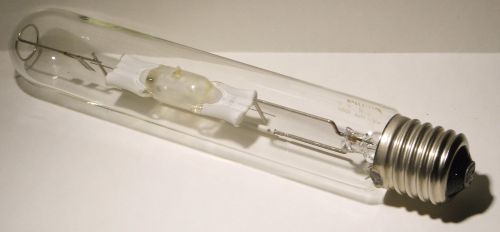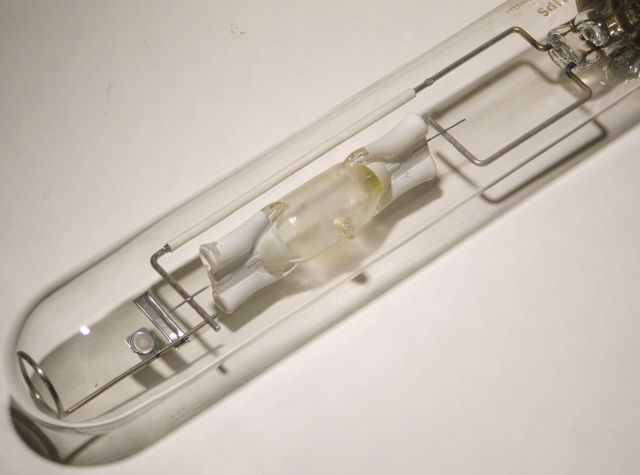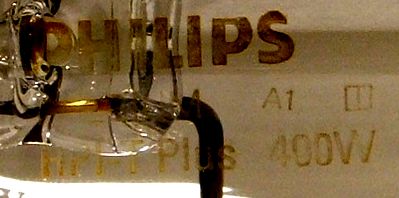
| Manufacturer: | Philips |
| Model: | HPI-T Plus 400W |
| Application: | Industrial High CRI lighting |
| Wattage: | 390W (On HPL gear) 445W (On SON gear) |
| Diameter (max): | 47mm |
| Length: | 286mm |
| Arc Tube Length: | 40mm |
| Bulb/Tube material: | Inner: Quartz. Outer: Hard Glass |
| Colour Temperature: | 4300K on HPL gear, 4000K On SON gear |
| Colour Rendering Index: | Ra 65 |
| Peak output wavelength: | Broadband |
| Total light output: | 35'000 Lm (89.74Lm/W) on HPL gear, 38'000 Lm (85.39Lm/W) on SON gear |
| Rated lifetime: | Not stated on datasheets |
| Cap: | E40 |
| Operating voltage: | 125V |
| Operating current: | 3.4A on HPL gear, 3.8A on SON gear |
| Warmup/restrike time: | 1.5 minutes/not stated |
| Cost (original): | Unknown |
| Place of manufacture: | Belgium |
| Date of manufacture: | January 2001 (Date code A1) |
| Lamp Status: | Working |
This is an example of a type of lamp Philips have developed which is starting to gain quite an acceptance, bringing the advantages of good quality white light, a high colour rendering index and high luminous output of metal halide technology into applications where previously high pressure sodium lamps were the popular choice. To emphasise this fact, this series of lamps is electrically and mechanically compatible with existing SON (high pressure sodium) control gear, meaning that the upgrade cost when switching from high pressure sodium light to metal halide is cut significantly when doing so by switching to these lamps. Normally switching lighting technologies would require at least the ballast and igniter in the fixture in question, whereas in this case all that is needed is for a new lamp to be fitted - even the "integral" style of high pressure sodium lamps have been catered for - there is a version of the HPI lamp, with the -S suffix, which has an internal starter. Other lamps require a high voltage external igniter, as with SON lamps.
The only difference, is that the majority of this series of lamps require a closed fixture with a front cover of hard glass, whereas the vast majority of SON lamps can be operated in open fixtures. There are however versions of this lamp with the -P suffix which are protected by a Teflon coating on the outer envelope, making the lamps suitable for use in open fixtures.
As with SON lamps, these are available in a huge range of wattages, starting at 250W (which is admittedly rather high compared to the smaller SON lamps), right through to a maximum 2000W - giving out a rather crazy figure of 200'000 Lumens. Not one you'd want to put in your living room that, not unless you want to leave your shadow burned into the wall when you leave anyway!
These metal halide lamps are slightly less efficient than their SON counterparts, the 400W lamp here achieving a respectable 89.7Lm/W, whereas its SON equivalent comes in at 120Lm/W. The figure is still highly respectable though, and the approximate 25% drop in efficacy when fitting this HPI lamp rather than a 400W SON lamp is likely seen as a worthwhile sacrifice in return for getting clean white light with good colour rendering abilities in a lot of cases.
NOTE: I do not presently have gear on which to operate this lamp. Operational photographs and a spectral analysis image will be added once I acquire such equipment.

Philips HPI-T Plus 400W Metal Halide Lamp - General overview

Philips HPI-T Plus 400W Metal Halide Lamp - Showing lamp cap

Philips HPI-T Plus 400W Metal Halide Lamp - Showing size of lamp

Philips HPI-T Plus 400W Metal Halide Lamp - Detail of arc tube and support framework

Philips HPI-T Plus 400W Metal Halide Lamp - Detail of text printed on lamp (contrast enhanced to improve readability)

This lamp added to the Virtual Display Shelf on the 16th March 2006 at 21:28.
References: Philips Online lamp catalogue.
Acknowledgements: Many thanks to Maxime Gendre for supplying this lamp for exhibition.
This page last updated:
18th June 2023: Made some changes to page format to improve readability on mobile devices. Some background code changes have also been made to improve search engine performance.